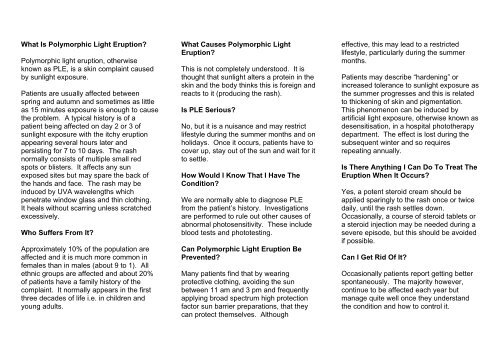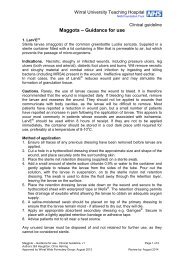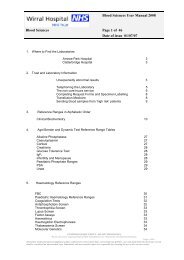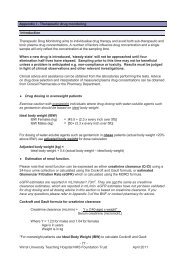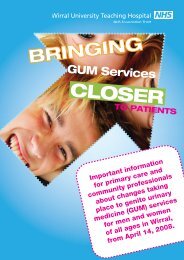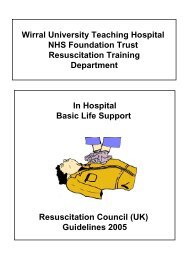You are allergic to para tertiary butyl phenol formaldehyde resin
You are allergic to para tertiary butyl phenol formaldehyde resin
You are allergic to para tertiary butyl phenol formaldehyde resin
You also want an ePaper? Increase the reach of your titles
YUMPU automatically turns print PDFs into web optimized ePapers that Google loves.
What Is Polymorphic Light Eruption?Polymorphic light eruption, otherwiseknown as PLE, is a skin complaint causedby sunlight exposure.Patients <strong>are</strong> usually affected betweenspring and autumn and sometimes as littleas 15 minutes exposure is enough <strong>to</strong> causethe problem. A typical his<strong>to</strong>ry is of apatient being affected on day 2 or 3 ofsunlight exposure with the itchy eruptionappearing several hours later andpersisting for 7 <strong>to</strong> 10 days. The rashnormally consists of multiple small redspots or blisters. It affects any sunexposed sites but may sp<strong>are</strong> the back ofthe hands and face. The rash may beinduced by UVA wavelengths whichpenetrate window glass and thin clothing.It heals without scarring unless scratchedexcessively.Who Suffers From It?Approximately 10% of the population <strong>are</strong>affected and it is much more common infemales than in males (about 9 <strong>to</strong> 1). Allethnic groups <strong>are</strong> affected and about 20%of patients have a family his<strong>to</strong>ry of thecomplaint. It normally appears in the firstthree decades of life i.e. in children andyoung adults.What Causes Polymorphic LightEruption?This is not completely unders<strong>to</strong>od. It isthought that sunlight alters a protein in theskin and the body thinks this is foreign andreacts <strong>to</strong> it (producing the rash).Is PLE Serious?No, but it is a nuisance and may restrictlifestyle during the summer months and onholidays. Once it occurs, patients have <strong>to</strong>cover up, stay out of the sun and wait for it<strong>to</strong> settle.How Would I Know That I Have TheCondition?We <strong>are</strong> normally able <strong>to</strong> diagnose PLEfrom the patient’s his<strong>to</strong>ry. Investigations<strong>are</strong> performed <strong>to</strong> rule out other causes ofabnormal pho<strong>to</strong>sensitivity. These includeblood tests and pho<strong>to</strong>testing.Can Polymorphic Light Eruption BePrevented?Many patients find that by wearingprotective clothing, avoiding the sunbetween 11 am and 3 pm and frequentlyapplying broad spectrum high protectionfac<strong>to</strong>r sun barrier pre<strong>para</strong>tions, that theycan protect themselves. Althougheffective, this may lead <strong>to</strong> a restrictedlifestyle, particularly during the summermonths.Patients may describe “hardening” orincreased <strong>to</strong>lerance <strong>to</strong> sunlight exposure asthe summer progresses and this is related<strong>to</strong> thickening of skin and pigmentation.This phenomenon can be induced byartificial light exposure, otherwise known asdesensitisation, in a hospital pho<strong>to</strong>therapydepartment. The effect is lost during thesubsequent winter and so requiresrepeating annually.Is There Anything I Can Do To Treat TheEruption When It Occurs?Yes, a potent steroid cream should beapplied sparingly <strong>to</strong> the rash once or twicedaily, until the rash settles down.Occasionally, a course of steroid tablets ora steroid injection may be needed during asevere episode, but this should be avoidedif possible.Can I Get Rid Of It?Occasionally patients report getting betterspontaneously. The majority however,continue <strong>to</strong> be affected each year butmanage quite well once they understandthe condition and how <strong>to</strong> control it.
Is It Infectious?No. There is no risk of other peopledeveloping the condition after coming in<strong>to</strong>contact with you.Is It Hereditary?Derma<strong>to</strong>logy DepartmentAbout 20% of patients have affected familymembers.Which Sun Screen Should I Use?We suggest the use of a broad spectrumsun block (protecting from both ultraviolet A+ B) applied regularly during sunlightexposure.Author:Contact Details:Date of Publication:Date for Review:Ref Source ofInformationDr SI White & Dr SKJones, ConsultantDerma<strong>to</strong>logists0151 334 4000June 2008June 2010British Association ofDerma<strong>to</strong>logistsPatient Information LeafletPolymorphicLightEruptionWirral University Teaching HospitalNHS Foundation TrustClatterbridge HospitalBebing<strong>to</strong>n, Wirral CH63 4JYWirral Hospital operates a ‘no smoking’policy and from March 2006 is <strong>to</strong>tallysmoke free on all sites


